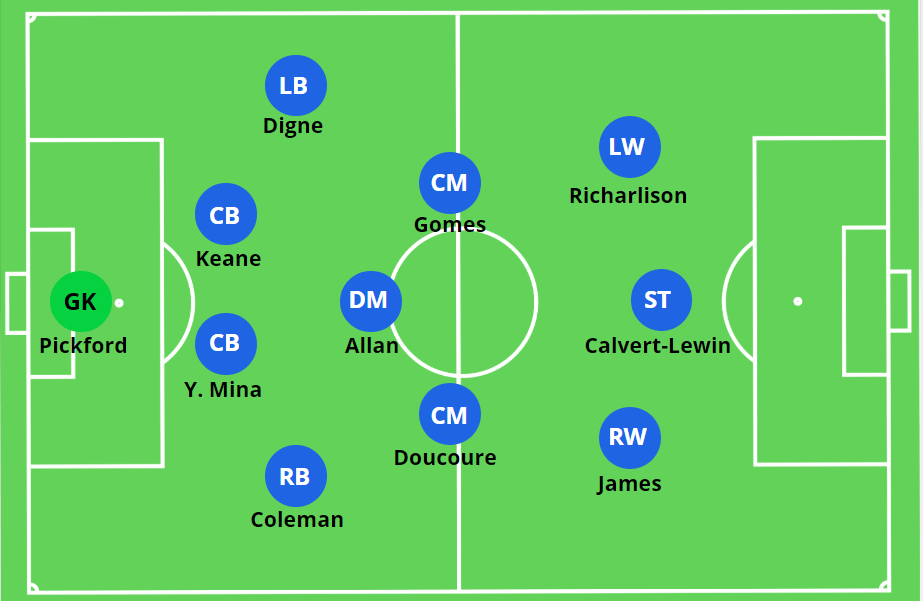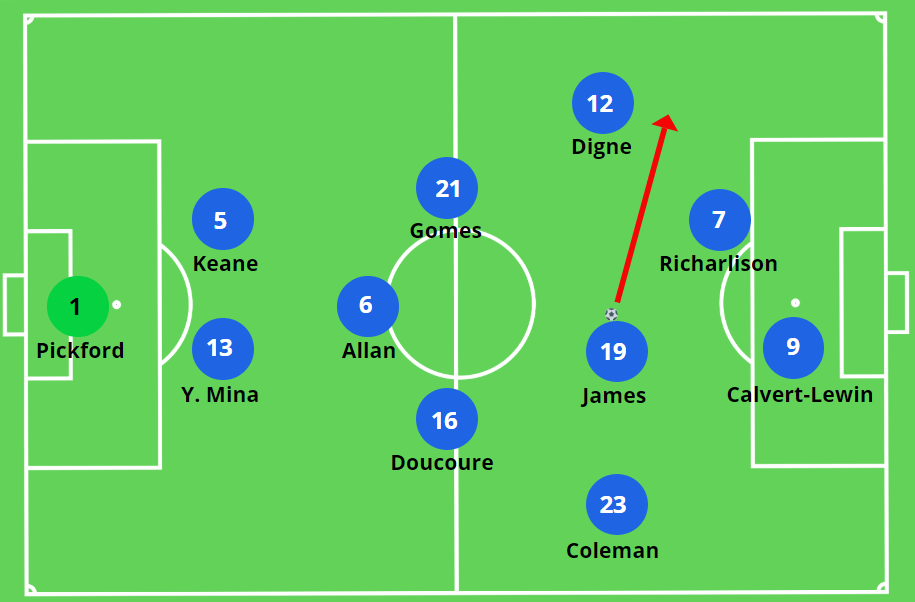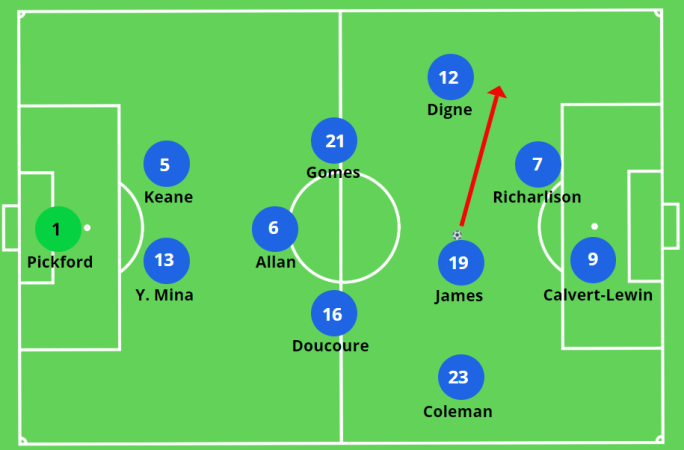After David Moyes left Everton for Manchester United in 2013, the Toffees haven’t been the same. They had a decent three years with Roberto Martinez until 2016, and perhaps their biggest mistake was letting the Spanish manager go. Ronald Koeman, Sam Allardyce and Marco Silva all failed to make an impact at Everton and finally the board said enough was enough and splashed the cash for one of the biggest names in the business – Carlo Ancelotti. Ever since, the men in blue have been flying high in the Premier League, playing fantastic football along the way. This season, Ancelotti’s side have started better than any other Premier League team and as things stand, sit at the top of the table with three wins from three. With fantastic new signings in James Rodriguez, Allan, Abdoulaye Doucore, and the rising form of Richarlison and Dominic Calvert-Lewin, Everton fans have plenty to be excited about this campaign. Here is a Tactical Analysis of Carlo Ancelotti’s Everton so far in 2020-21.
SYSTEM OF PLAY: 4-3-3

Everton have operated all three of their Premier League games so far in the tried and tested 4-3-3 formation. Although calling it a 4-3-3 is true, the way they operate within their system is very flexible and allows the freedom of a few key individuals to play out of position from what you would normally expect in a 4-3-3.
Most notably, James Rodriguez has operated largely as a right-sided attacking midfielder, rather than an out and out right winger. He plays centrally far more often than wide, and often comes deep to pick up possession. This has allowed Seamus Coleman to frequently overlap the right hand side, where he’s been very effective in the final third. Richarlison meanwhile has been far from an out and wide left winger and has often found himself alongside Dominic Calvert-Lewin up front, allowing Lucas Digne to overlap down the left-hand side in response. In the final third, the shape looks more like a 2-3-3-2, which of course, is not a football formation.

When Ancelotti first came into the club he favoured the 4-4-2, which often became a 4-2-4 in attack. However, the arrivals of Allan and Abdoulaye Doucoure in midfield have seemingly put that to rest, as Ancelotti now has a plethora of midfield options he can rely on to get the best out of his team going forward. If a change of system were to occur, a 4-2-3-1 might be more likely, as James Rodriguez is pushed inside as a ‘number 10’ and a winger like Alex Iwobi or Theo Walcott is deployed in his position. The former Champions League winning manager also has Gylfi Sigurdsson at his disposal as an additional attacking midfield option should he be required.
So before delving into the specifics of their play, let’s quickly run through who Ancelotti has favoured at the start of the season, as it’s been the same eleven players (and largely the same substitutes) for all 3 matches so far. Jordan Pickford has retained his place in goal for the fourth season running. In fact you’d hate to be the back up to England’s number 1 goalkeeper, as the 26 year old hasn’t missed a league game since he joined the club. In defense, Seamus Coleman and Lucas Digne have retained their places as the two fullbacks. But Everton may be looking for reinforcements on the bench moving forward, as Leighton Baines and Djibril Sidibe are no longer with the club. Yerry Mina and Michael Keane have been Ancelotti’s preferred partnership at the back since he joined the club and that looks set to stay that way throughout the season, as Mason Holgate remains the only other serious option. In midfield, Abdoulaye Doucoure, Allan and Andre Gomes have forced the likes of Gylfi Sigurdsson and Fabian Delph out of the side, while Richarlison and James Rodriguez have formed perfect symmetry with their asymmetry in attack. Dominic Calvert-Lewin leads the line, as the club continues to ease Moise Kean into life in England. In the three matches so far only 15 players have featured, with Alex Iwobi and Tom Davies the other two players to act as substitutes, alongside Sigurdsson and Kean. Now, let’s get right into the nitty-gritty of this tactical analysis!
A TARGET MAN WITH NO LONG BALLS?
Although Dominic Calvert-Lewin has received much of the plaudits this season for his goal-scoring abilities, he’s actually been relatively disengaged when Everton are in possession of the ball. He’s completed just 14 passes per game so far, with the Toffees instead having much of the ball in their defensive third and middle of the pitch, working their way up to the big man up top meticulously and patiently. It seems as though Everton hardly ever rush the ball forwards to Calvert-Lewin or attempt to play the long-ball. He’s not a target man in the sense that he’ll climb up in the air and knock it down for other players. Instead, he operates off the shoulder of the defenders like a fox in the box and comes alive whenever the ball is played from a cross or incisive pass into the penalty area. He’s actually quite an anomaly in this regard in the whole of the Premier League, as most of his touches either come from shots (often just one-touch finishes) or winning duels in the air (such as heading it at goal). This, coming from a player who started his Everton career on the left-wing, is a bit strange. But concomitantly, it showcases just how clever Ancelotti has been in getting the best out of the 23-year old, who has developed into an out-and-out centre-forward that opposition defenders simply just cannot get their hands on. With Duncan Ferguson coaching behind the scenes, Everton have a clever centre-forward who can act as a target man, without ever needing to shift away from their short-passing, progressive possession model.
JAMES RODRIGUEZ’S CENTRAL ROLE
James Rodriguez is quite possibly one of the smartest buys in the past five years in the Premier League. He’s been brilliant so far to start his Everton career and at every turn of the way has played to his strengths (with the team helping him do so); contributing massively to Everton’s glorious start to the season. Other than Jordan Pickford, James is the only Everton player frequently attempting long ball passes, which have been far more horizontal and diagonal than vertical. The Colombian has been incredibly adept at picking out these longer passes so far, completing 7.7 long-passes per game, compared to just 1 incomplete long pass per game. This has offered Everton a different threat that they haven’t had in recent seasons. Due to his incredible ability, Everton have now become a side capable of switching play from left to right, further taking advantage of their attack-minded fullbacks.

The Colombian midfielder is almost like the maverick of the team. He gets on the ball at every opportunity, attempting to spray the ball from right to left whenever it’s on, setting his fullbacks free down the wing, looking for the powerful runner Richarlison in space, or playing it cool and going backwards to the pass masters in midfield. As everyone else is playing a short passing game, Rodriguez has the freedom to go on and try riskier passes, which have so far, been highly successful.
The other key part of James Rodriguez’s game under Ancelotti has been his understanding of where to find space in central areas. He’s played more like an attacking midfielder (or at the very least one operating slightly to the right) without being an out-and-out winger. What this has allowed for Everton in possession is an extra man in midfield to create overloads and switch the play down their favoured side on the left. 43% of Everton’s attacks have come down the left-side, despite all of James’ touches on the right. With Lucas Digne, Andre Gomes and Richarlison operating on the left, it’s easy to see why James has been looking to play a cross-field pass to that side so often. After the switch of play, Everton look to attack at speed and try to make some magic happen before the opposition have time to react. They have often been quite successful in doing so and this type of switching play has been a key chance creating mechanism for the Toffees. James Rodriguez is undoubtedly the maverick of this Everton side and if Ancelotti’s side are to achieve dreams of a top four finish, they wil have to hope the Colombian stays fit all season long.
MIDFIELD CHEMISTRY
The most obvious of revelations this season under Carlo Ancelotti has been the change of shape to a midfield three, relying on two massive new signings for the club in Allan and Abdoulaye Doucoure, alongside former Barcelona man Andre Gomes. Allan sits in front of the back four as both a screen and pivot, dictating the tempo of the game from deep. Playing as the ‘number 6’ in the side and quite literally with the shirt on his back, he is an excellent progressor of the ball and rarely misses a pass. He’s also decent in transition, aiding Everton’s ability to win the ball back immediately after losing it in central areas. The Brazilian has won 4 tackles per game this season, more than any other Everton player, and the fourth best in the league in that regard. But the Brazilian’s also aided by two very defensively sound and astute midfielders who have historically played in a midfield two (albeit for different clubs). Abdoulaye Doucoure is incredibly mobile and positionally sound, which helps the left-footed James Rodriguez to have his free role on the right of Everton’s wing. It also aids in Allan’s ability not to have to do all the defending on his own. Although Gomes is decent defensively, good in the tackle and displays an excellent passing range, he’s much less defensively aware and less likely to get his body in the way of an incisive pass. So having two men in midfield that are particularly adept at doing so has really aided Everton’s cause this season, and allowed other players to get the best out of their abilities further forward. In comparison to last season, Everton often relied on a midfield two with no real number 6 and Gylfi Sigurdsson often operating more like a number 10. This level of balance caused Everton some issues, particularly in defensive transitions where they didn’t have that same defensive stability and cover.
Embed from Getty ImagesFurther, with this defensive cover in midfield, the fullbacks have greater license to go forward. Andre Gomes will rarely be caught making a lung-bursting run forward, while Abdoulaye Doucoure has had to slow that side of his game, to allow for the dangerous wide play of Everton’s fullbacks – Seamus Coleman and Lucas Digne. With James Rodriguez also often operating in central areas and allowing for those overlaps and/or switches of play, the Toffees have four men in central areas that the opposition will need to bypass in order to go on the break and counter attack against Ancelotti’s side. This makes them nearly impossible to play through, and it’s one of the key reasons they’ve been so defensively resilient to start this season.
Speaking of their ability to defend on the break, Richarlison is also a bit of an incredible anomaly. Only Allan has made more tackles than the Brazilian forward (3.7 per game) this season for Ancelotti’s side. When you add that level of work ethic into the mix right from the front of Everton’s lineup, it becomes even more difficult to catch them sleeping on the counter attack. Evidently, even a counter attacking side as capable as Crystal Palace had issues pulling their usual heights off in Everton’s third match of the season.
A THREAT FROM SET-PIECES
The final tactical particularity worth noting about Everton is their threat from set-pieces. The Toffees have scored eight goals so far in their three matches, four of which have come from open play, and four of which (including a penalty shot) have come from set-pieces. This illustrates just how dangerous Ancelotti’s side can be from a variety of different situations. If they’re having trouble breaking their opposition down, they can score from a corner kick or perhaps even a free kick. Having the ability to score goals in a variety of different ways is a feature of every top team and it will be important to Everton this season. Their ability from set-pieces is unsurprising, given the capability of players like Lucas Digne, James Rodriguez and maybe in time, Gylfi Sigurdsson, to deliver the ball. When you add in targets like Michael Keane, Yerry Mina and Dominic Calvert-Lewin, who are all great in the air, you have a recipe for success. With Everton becoming more and more of a possession-based side under Ancelotti, how much set-pieces will become a feature of their play is probably minimal. But it will still nonetheless be another great asset to have at their disposal.
CONCLUSION
Everton’s form has been impeccable to start this Premier League season and three wins from three is exactly what Ancelotti would have been dreaming about. The new signings have all fit in perfectly and the Toffees look to being gelling better than any other side in the league. With their defensive-minded midfield trio and intriguing asymmetry of the front three, Everton are set up well to have much success this season.
So there it is! A tactical analysis of Carlo Ancelotti’s Everton so far in 2020-21. Can Ancelotti’s side go the distance and crack the top four this season? Share your thoughts in the comments below or on Twitter @mastermindiste. Thanks for reading and see you soon!
You might also enjoy…
-> Roy Hodgson – Crystal Palace – Tactical Analysis
-> Marcelo Bielsa – Leeds United – Tactical Analysis
-> Chris Wilder – Sheffield United – Tactical Analysis
-> Brendan Rodgers – Leicester City – Tactical Analysis


16 thoughts on “Carlo Ancelotti – Everton – Tactical Analysis”